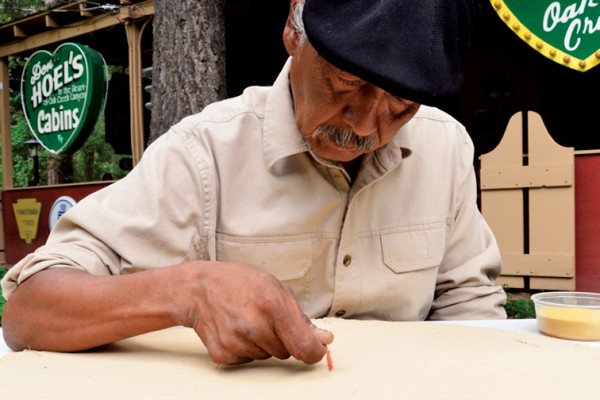Continued (page 2 of 3)
Instead, the present-day trail begins at a parking lot just below the Arizona Snowbowl ski resort. Prior to our hike, the Coconino National Forest website measured Humphreys Trail No. 51 at 9 miles round trip. But when we finished our adventure – in the dark, but more on that later – our GPS device said the hike was exactly 11.5 miles. When we reported this to the forest service, Brady explained that the 9-mile figure was devised by using a measuring wheel. Brady actually took our findings to heart, and changed the Coconino National Forest’s website. Who says you can’t effect change?
The trail begins with a deceptively flat walk across the base of the mountain with stands of aspen trees in the distance. If you’re hiking in October, the leaves on the trees are a brilliant gold color. After one-third of a mile, you abruptly enter a mixed conifer forest with Douglas fir, blue spruce and ponderosa pine trees providing plenty of shade. Oddly enough, you won’t find the trail register until you’ve hiked 1.3 miles; make sure you sign in. The smell of the trees and the crunching of pine needles under our boots in this part of the forest reminded us that Christmas was less than three months away – yikes!
The first notable sight on the hike comes after you’ve been hiking 2.76 miles: the remnants of an enormous rock slide. A sea of huge, black basalt boulders cascades down the steep mountain, easily inducing feelings of dizziness and vertigo. If you aren’t faint of heart, venture out on the rocks (watch your footing – the rocks are loose) and take in the view. During our hike, we were treated to a sea of colorful aspens in Hart Prairie, far below. Above us, the boulders seemed to go on forever until finally meeting with the intensely blue sky. It was just the first of many amazing vistas we would encounter.
From the rock slide, the trail continues to climb uphill, and though it’s not as steep as some of the trails in Oak Creek Canyon (and though our group lives at 4,500 feet), the elevation makes breathing a challenge. It’s slow going on this trail, but we weren’t in a race. We crossed over another rock slide after hiking 4 miles, and this time there was driftwood mixed with the rocks, an interesting contrast. By now we had entered a subalpine conifer forest with Englemann spruce trees and cork-bark firs. In another half a mile, we had reached the saddle between Agassiz Peak and Humphreys Peak. Everyone agreed that the rocky talus slope that leads to the saddle was the most difficult part of the trail thus far. The saddle is located at an elevation of 11,800 feet and though you are still below the tree line, you have breathtaking views of Lockett Meadow (also colored gold during our hike thanks to the aspens), reddish-purple Sunset Crater and the Painted Desert, all to the east. The Weatherford Trail joins Humphreys Trail at the saddle. It was here that we decided to stop for lunch and update our Facebook statuses (yes, we actually had 3G at the saddle) while white-throated swifts and ravens soared overhead. A brisk wind made us don extra layers of clothes and encouraged us to hurry through lunch and make the final push to the summit.
As soon as we got back on the trail, it became obvious why so many people stop at the saddle. At first, you pass by bristlecone pines, bent and twisted by the wind and weather. The bristlecone is thought to be the oldest life form on earth; the oldest of the species, named Methuselah, lives in eastern California and is nearly 5,000 years old. We admired the trees’ tenacity, but to be honest, we were more concerned about watching our footing. The last mile of Humphreys Trail is one of the rockiest hikes we’ve experienced, and that’s saying a lot coming from veteran Red Rock Country hikers (no tenderfoots here). Couple that with the fact that you are entirely exposed to the elements and breathing exceptionally thin air, and you’ll understand why we had to pause to catch our breath so frequently. It gave us time to examine the alpine tundra and look for evidence of the threatened San Francisco Peaks groundsel, which can only be found in this location. Yet with every cautious footstep, the trek was also incredibly exciting. Here we were, four people dwarfed by our terrain, hunched in the wind and scrambling up the side of the highest mountain in Arizona. To our left was a sheer drop; one miscalculated slip and we would fall an infinite distance to certain death. To our right, undulating rocky slopes greeted us. We were surprised by the dozens of hikers of all shapes, sizes and ages who passed us as they made their way down the mountain. As strenuous as it is, Humphreys Trail is very popular when the weather is right.



